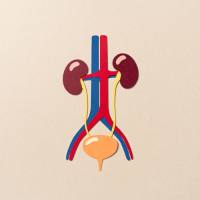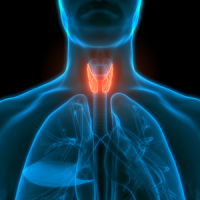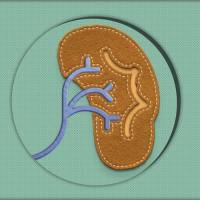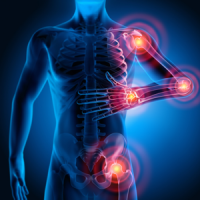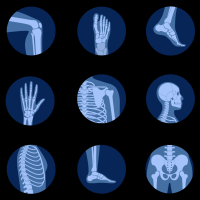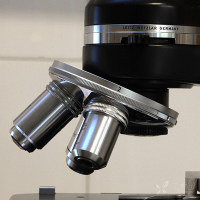病例分享:一名伴有心包和胸腔积液的 11 岁男孩的复发性皮疹
Recurrent Rash in an 11-Year-Old Boy With Pericardial and Pleural Effusions
Allison M. Weisnicht, MD; Ryan Byrne, MD; Erin B. Henkel, MD; Stephen A. Harding, MD; Stefan P. Kostelyna, MD; Deborah Schady, MD; Jamie Lai, MD; Leigh A. Stubbs, MD–MPH
An 11-year-old, previously healthy boy presented to the emergency center (EC) for acute respiratory distress in the setting of 5 months of recurrent and worsening rash with progressive fatigue, shortness of breath, chest pain, and cough. At the onset of his rash, he and his younger brothers were diagnosed with roseola. Although his brothers’ symptoms resolved, the patient’s rash recurred, prompting his primary care provider to prescribe amoxicillin. The rash subsequently worsened, so amoxicillin was stopped; a prednisone course was prescribed which alleviated the rash. Upon completion of the prednisone course, the rash returned more diffusely with associated symptoms of shortness of breath, chest pain, and cough. Because of these symptoms, his mother brought him to the EC, where his vitals were notable for tachypnea and tachycardia. His initial EC imaging workup was remarkable for an echocardiogram with a mild to moderate circumferential pericardial effusion, chest x-ray (CXR) with a large right pleural effusion, and chest computerized tomography significant for prominent and diffuse mediastinal and hilar lymphadenopathy with numerous enlarged axillary lymph nodes. Laboratory results were notable for elevated liver enzymes, inflammatory markers, d-dimer, and brain natriuretic peptide. Differential diagnosis remained broad, including infectious, oncologic, and rheumatologic etiologies. Our panel of experts reviews the evaluation, hospital course, and treatment of this patient presenting with an unusual rash and serositis.
Case History With Subspecialty Input
Drs Weisnicht and Kostelyna (Pediatrics, Residents)
A previously healthy 11-year-old boy presented in February 2021 to a community pediatric emergency center (EC) with chief complaint of shortness of breath, fatigue, chest pain, and cough, in the setting of 5 months of a recurrent rash. In the months before his EC presentation, he and his 2 younger brothers developed a rash that was attributed to roseola. His brothers’ rashes resolved; however, his persisted. Further workup with his primary care physician (PCP) included negative coronavirus disease 2019 testing. His rash was treated as a staphylococcal infection with amoxicillin and topical mupirocin. A few days into his antibiotic course, his rash worsened. Because of concerns for a drug reaction, amoxicillin was discontinued, and he was started on a course of prednisone. His rash resolved on the prednisone course, but after completion of the prednisone, the rash returned more extensively, involving new areas of the body including the neck and arms, with worsening of existing areas on his chest. Additionally, he developed new associated symptoms of difficulty breathing, coughing, wheezing, chest pain, and arthralgias 3 days before his EC presentation.
On EC presentation, he was noted to be in respiratory distress, with a respiratory rate of 32 breaths per minute, oxygen saturation of 95% on room air, heart rate of 148, blood pressure of 124/61 mmHg, and temperature of 37.2°C. His height and weight were both near the 99th percentiles for age. His physical examination was notable for frequent forceful coughing, bilateral subconjunctival hemorrhages, diffuse expiratory wheezing, and erythematous coalescing annular plaques with elevated borders on his chest, neck, upper extremities, and back (Fig 1). He reported a burning sensation with his skin lesions.
Dr Henkel, What Is Your Differential Diagnosis for This Patient Based on the Information Gathered in the EC?
Dr Henkel (Pediatric Emergency Medicine)
Given the chronicity and evolution of symptoms, the initial differential was broad, including infectious, oncologic or paraneoplastic, and rheumatologic etiologies. A trial of inhaled albuterol was given, with some improvement in wheezing, but he continued to have persistent tachycardia and tachypnea, with oxygen saturation remaining in the mid-90s. Initial laboratory results were significant for mild anemia, as well as elevated liver enzymes, inflammatory markers, brain natriuretic peptide, and d-dimer (Table 1). Troponin, ferritin, creatinine, and urinalysis were within normal limits. Viral studies demonstrated positive rhinovirus polymerase chain reaction with negative severe acute respiratory syndrome coronavirus 2 (polymerase chain reaction) and antibodies. An electrocardiogram demonstrated sinus tachycardia with nonspecific ST and T wave abnormalities, and a borderline prolonged QTc of 457 ms. Bedside point-of-care cardiac ultrasound showed a small pericardial effusion with overall good function. A normal saline bolus of 500 mL (<10 mL/kg) was given. Cardiology was consulted for a formal transthoracic echocardiogram (TTE). His TTE showed a mild to moderate circumferential pericardial effusion on parasternal short axis view (Fig 2A). Although the images suggested mild tamponade physiology, with >30% variation in mitral valve inflow with respiration, we clinically did not have concern for tamponade and the effusion was determined to be too small to require drainage. Cardiology deduced that the inflow variation was more likely because of significant respiratory distress during the study. He was transferred to our quaternary pediatric center and admitted to the cardiology service with multidisciplinary care for his broad differential diagnosis.
Dr Byrne, What Is Your Initial Approach to a Child Presenting With an Undifferentiated Pericardial Effusion?
Dr Byrne (Pediatric Cardiology)
The approach to a pericardial effusion is multifactorial and dependent on the underlying etiology. The causes of pericardial effusion include inflammation, infection, malignancy, trauma, postsurgical, kidney failure, medications, or toxins. The rate at which the pericardial fluid accumulates typically dictates the clinical presentation. The normal pericardial sac contains up to 50mL of physiologic plasma ultrafiltrate and less in younger children.1 Rapid accumulation of fluid beyond a normal physiologic pericardial volume can significantly increase the intrapericardial pressure and lead to early signs and symptoms of cardiac tamponade. Slower accumulation of fluid is typically better tolerated and can result in accumulation of larger volumes before detection, such as in our patient’s case.
TTE can be helpful in determining the size and distribution of a pericardial effusion. It may also identify fluid characteristics such as fibrin stranding, inflammatory debris, or coagulum. Effusion size is classically defined as small (<10 mm), moderate (10–20 mm), or large (>20 mm); however, qualitative assessment of size is more commonly used in the pediatric population.2 The effusion distribution can be circumferential or localized. Although cardiac tamponade is a clinical diagnosis, TTE is helpful in assessing for associated findings. Given the lower pressures of the right-sided chambers, increased pericardial pressures impact the right atrium and right ventricle at earlier hemodynamic stages.3 Thus, early diastolic right atrial or right ventricular collapse are considered early and sensitive findings of cardiac tamponade. Other echocardiographic findings associated with cardiac tamponade include dilation of the inferior vena cava, bowing of the ventricular septum into the left ventricle, and increased respiratory variation of tricuspid or mitral valve inflow.
Pharmacologic treatment of a pericardial effusion should be directed toward the underlying etiology. Diuresis should be avoided because preload is already reduced in the setting of tamponade given impaired ventricular filling. If cardiac tamponade is identified, echocardiographic-guided pericardiocentesis and/or placement of a pericardial drain is warranted. Surgical drainage could also be considered; however, it is often limited to situations such as hemopericardium with active bleeding into the pericardial space where achieving hemostasis is also required or the early postoperative setting.
In cardiac tamponade, inflow velocities across the atrioventricular valves can have exaggerated variability during respiration because of abnormal intrapericardial and intrathoracic pressure interactions. Although mitral valve inflow variability was mildly elevated on our patient’s initial TTE, this could have been overestimated given the patient’s concomitant respiratory distress. There was normal tricuspid valve inflow variability, no right-sided chamber diastolic collapse, and, importantly, no clinical evidence of cardiac tamponade. Repeat TTE the following day revealed a stable pericardial effusion and normalized mitral valve inflow variability. With treatment, the patient’s pericardial effusion would ultimately resolve without need for pericardiocentesis or drainage. Cardiology remained actively involved with the patient’s care throughout his hospitalization.
Drs Weisnicht and Kostelyna
Given his presentation with respiratory distress and an elevated d-dimer, the patient underwent computerized tomography (CT) of his chest that demonstrated no pulmonary embolism but did show significant mediastinal, hilar, and axillary lymphadenopathy with small bilateral pleural effusions (right greater than left). The radiologist’s impression was suggestive of a lymphoma or lymphoproliferative disease, which in conjunction with his constitutional symptoms of weight loss and fatigue, prompted an oncology consultation. The patient’s mild microcytic anemia with otherwise normal white blood cell count without blasts, normal tumor lysis laboratories, and absence of a mediastinal mass made suspicion lower for leukemia or Hodgkin’s lymphoma; however, cutaneous T cell lymphoma remained on the differential in the setting of his rash and lymphadenopathy.
Because of concern for a potential oncologic process, an excisional lymph node biopsy was recommended. However, after evaluation from general surgery, there was not an easily accessible lymph node, so a positron emission tomography (PET) scan was performed. The PET scan showed multifocal, faintly hypermetabolic lymph nodes within the neck, chest, and bilateral inguinal regions. This appearance was more typical for reactive lymphadenopathy rather than neoplasia. Similarly, there was faintly increased background uptake throughout the spleen, along with faintly hypermetabolic skin changes in the thorax, which can be seen in the setting of systemic inflammation or infection. Overall, this patient’s presentation, along with PET/CT and laboratory findings, were not consistent with a malignancy and instead favored an underlying inflammatory or atypical infectious process.
Shortly into his hospital course, his CXR showed a worsening right-sided pleural effusion with a stable small left pleural effusion (Fig 2B). He required right-sided chest tube placement, with the pleural fluid showing mixed inflammatory cell infiltrate with a neutrophil predominance and no cytologic atypia. The patient was also noted to be emotionally labile and anxious during the hospitalization, which his mother noted was not typical of his personality and correlated with the onset of his other symptoms. His skin lesions continued to appear in new locations, with individual lesions persisting for 24 to 72 hours before fading and leaving behind irregular hyperpigmented plaques (Fig 1). Dermatology was consulted and performed a punch biopsy, which showed leukocytoclastic vasculitis with perivascular predominantly neutrophilic infiltrate. Endothelial cell swelling was present with fibrin deposition in the involved blood vessels (Fig 3A–C). His skin biopsy findings, in conjunction with clinical appearance of the lesions, were consistent with urticarial vasculitis.
Autoimmune and Rheumatologic Conditions Can Often Mimic Malignancy, With Vague Presentations Evolving Over Weeks to Months. Dr Stubbs, Are There Any Aspects of This Case That Favor an Autoimmune Rather Than Neoplastic Etiology?
Dr Stubbs (Pediatric Rheumatology)
Many rheumatologic diagnoses require exclusion of other causes, especially infectious or oncologic. This is essential before starting any immunosuppressive treatment, such as corticosteroids, that could impact the treatment or outcome of other etiologies. During his concurrent infectious, neoplastic, and rheumatology evaluation, inflammatory etiologies of lymphadenopathy became higher on the differential diagnosis, especially after his PET scan. These etiologies can include systemic-onset juvenile idiopathic arthritis, systemic lupus erythematosus (SLE), Kawasaki disease, hemophagocytic lymphohistiocytosis, monogenic autoinflammatory diseases, Castleman disease, Kikuchi-Fujimoto disease, Rosai-Dorfman disease, serum sickness, and sarcoidosis.4 With his history of fever, leukocytoclastic vasculitis, and serositis, SLE was highest on the differential.
Overall, childhood-onset SLE (cSLE) is rare, with an incidence of ∼1 per 100 000 children per year.5 Similar to adult-onset SLE, there is a higher prevalence among Blacks, Hispanics, Asian Americans, and Native Americans compared with non-Hispanic Whites.5 The median age of cSLE is ∼11 to 12 years. It has a strong female predisposition; cSLE is ∼5:1 (female:male) compared with 9 to 10:1 in the adult SLE.5,6 The etiology of cSLE includes genetic and environmental triggers.5 He met the criteria for lupus with the following features: positive antinuclear antibody (ANA), fever, serositis, low complements, and positive direct Coombs’ test.7,8 He did not have significant leukopenia, thrombocytopenia, joint, or renal involvement. His antiphospholipid, anti-double-stranded DNA, anti-Smith antibodies, and antineutrophil cytoplasmic antibodies were negative. Although he had emotional lability, he did not have any delirium, psychosis, or seizures. A brain MRI was normal. Given his clinical and histology features of urticarial vasculitis, C1q was tested and found to be low.9–12 C1q deficiency is a rare immunodeficiency strongly associated with the development of SLE.13 Since he was a previously healthy child and complements improved with treatment, no further genetic testing was performed.
Drs Weisnicht and Kostelyna
At this point of his hospitalization, a more detailed social history was obtained, which revealed an environmental exposure. Five months before admission, the patient’s mother found him and his siblings playing with a “silver liquid.” The patient had been handling the substance with his bare hands. The mother tried to clean up the substance by sweeping it; however, it kept accumulating into beads, making it difficult to do so. Ultimately, she ended up vacuuming the substance. The mother confirmed that a close contact of the family worked in air conditioning repair, and the silver liquid was mercury. The patient was tested and found to have mercury intoxication, with elevated levels in his blood (72 μg/L) and urine (>80 μg/L). At this point, toxicology was consulted.
Dr Harding, What Is Known About Mercury Toxicity and What Is the Approach to Treatment?
Dr Harding (Toxicology)
Mercury toxicity has been studied since ancient times, even dating back to the first century anno domini.14 From exposures in mining, water contamination, and hat-making, historical mercury exposures have documented multisystemic symptoms.15 Erethism, which is a constellation of behavioral and neurologic changes observed among 1800s felt-hatmakers, led to the term “mad as a hatter.”14 It has also previously been used as a treatment of scabies, syphilis, and infant teething, with significant adverse effects.14
Potential exposures to mercury could include traditional medicines, cosmetics, batteries, seafood, broken thermometers, environmental, or occupational.16 Mercury is available in various formulations, including inorganic compounds, organic compounds, and elemental liquid mercury (quicksilver). Organic and inorganic mercury compounds are mainly absorbed via the gastrointestinal (GI) tract, whereas elemental mercury, as in this case, is mainly absorbed via inhalation.16 This risk can be increased by heating or aerosolization, such as by vacuuming.17 Once patients have inhaled elemental mercury, it is enzymatically converted from elemental mercury to mercurous (Hg+) and then mercuric cations (Hg2+). This allows the mercury to accumulate in the central nervous system (CNS).16 Peak concentrations in the CNS are reached in 2 to 3 days after a significant exposure.18 Mercury is excreted mainly via the kidneys and the GI tract, with a total body half-life of ∼30 to 60 days.18 Mechanistically, mercury acts by binding to sulfur, phosphoryl groups, carboxyl groups, and amide groups. Because these are ubiquitous throughout many organs, this results in widespread protein and enzyme dysfunction.16
Given its multisystemic presentation, patients with mercury intoxication have previously been misdiagnosed and referred to a rheumatology clinic in a recent case series.19 Pediatricians should have a high index of suspicion for acute mercury poisoning in patients presenting with vague symptoms of multisystem involvement, including respiratory (cough, dyspnea), dermatologic (rash), and GI (nausea, vomiting, diarrhea), with a history concerning for exposure. Alternatively, patients presenting with new, primarily neuropsychiatric symptoms, including tremors, personality changes, and memory loss along with a desquamating rash, can indicate chronic mercury poisoning. Acrodynia “pink disease” is also a potential presentation of small children exposed to mercury, consisting of a diffuse erythematous body rash with involvement of the palms and soles followed by desquamation of skin. Other features of acrodynia include fever, irritability, and profuse sweating.20,21 In hindsight of this case, the patient’s brothers likely were presenting with acrodynia when their symptoms were attributed to roseola on their initial presentation to their PCP.
The initial management strategy for mercury poisoning is removal of the source and supportive care measures. In this case, an environmental evaluation was completed in the patient’s home. Environmental services investigated the patient’s home and detected mercury throughout, with an area of especially high concentration in the patient’s bedroom. This required the family to temporarily evacuate the residence for further decontamination. As demonstrated by the patient’s initial respiratory distress, the respiratory status of the patient with inhaled elemental mercury exposure needs to be carefully observed, including oxygen saturation levels and CXR findings; in severe cases, intubation may be required.22
Next, chelation therapy can be considered to mitigate the systemic effects of the exposure. Typical recommendations for chelation include intramuscular dimercaprol or succimer. Dimercaprol, in the setting of organic mercury toxicity, carries the risk of redistribution of mercury into the CNS.16 Given the unknown species of mercury in this case, the intramuscular route of administration, and the less-favorable side-effect profile, the decision was made to use succimer in conjunction with N-acetylcysteine. Chelation therapy with succimer was continued until the patient’s mercury levels had reached a normal value. In the case of elemental and inorganic mercury exposures, 24-hour urine mercury concentrations are the best method to monitor chelation therapy. Once mercury levels have normalized after completion of chelation therapy, assuming no further exposure to the mercury source, patients no longer require monitoring unless symptoms return. Of note, the patient’s younger brothers and mother were also found to have elevated mercury levels. At the time of the patient’s hospitalization, his family members displayed no symptoms, except for 1 of the younger brothers who had a unilateral enlarged cervical lymph node.
Dr Stubbs, Can You Describe How Drug-Induced Lupus Typically Presents and How This Case Differed? Is There Evidence Within the Literature for Mercury-Induced Autoimmunity?
Dr Stubbs
Drug-induced lupus erythematosus (DIL) is incited by chronic exposure to certain drugs that resolves after discontinuation of the culprit medication. Over 100 drugs have been implicated in DIL, of which procainamide and hydralazine have the highest risk.23,24 DIL is an example of how environmental triggers can lead to the development of lupus features in genetically susceptible individuals.24 DIL can commonly present with arthralgias, constitutional symptoms, serositis, and cutaneous features.25 Renal, CNS, and hematologic involvement are rare in DIL.25 Although DIL tends to be milder than SLE, it is not possible to distinguish between the two on the basis of clinical features alone. Laboratory evaluation often reveals normal complement and immunoglobulin levels in DIL, whereas complement levels are decreased and immunoglobulin levels are elevated in SLE.25 In a patient with lupus-like symptoms and exclusion of other autoimmune disorders, the diagnosis is made when symptoms resolve after stopping the culprit drug. Typically, DIL symptoms dissipate within a few weeks of drug discontinuation.24 However, residual antinuclear antibodies may persist for months to years.24 Generally, no specific treatments are indicated, but nonsteroidal antiinflammatory drugs or corticosteroids may be required for symptomatic management.
In this patient’s case, mercury intoxication appears to have triggered his lupus-like autoimmune disorder with hypocomplementemic urticarial vasculitis. Because this was his first episode and his symptoms resolved with normalization of mercury levels, it remains undetermined whether he will have the relapsing/remitting and episodic pattern suggestive of chronic SLE, or if, in the absence of further exposure, his symptoms will not recur. However, there is some evidence of an association between mercury exposure and the development of autoimmune conditions. Mercury-exposed gold miners had a higher prevalence of positive-ANA in comparison with emerald and diamond miners with no occupational mercury exposure.23 This was corroborated by a study of reproductive-age women that found that blood mercury levels were correlated with ANA positivity, even in a population without high-risk occupations or known high-level exposures.24 In 2020, a case series reported mercury-induced Morvan syndrome, an autoimmune disease of the nervous system.15 In addition to general mercury-induced autoimmunity, there is ongoing lupus research analyzing environmental factors that may act on an epigenetic level to promote the development of disease. One proposed mechanism involves altering CD4+ T-cell gene expression and leading to autoreactive, cytotoxic, and proinflammatory T cells involved in lupus onset and flares.25 In case control studies, self-reported exposure to mercury was specifically associated with an elevated risk of SLE.25 Further studies investigating modifiable environmental risk factors in SLE could advance our knowledge of disease pathogenesis and lead to prevention strategies.23
Drs Weisnicht and Kostelyna
Overall, this patient had a challenging initial inpatient hospitalization. His first chest tube was removed because he was significantly improving on corticosteroid therapy, and serial TTEs were performed that showed resolution of the pericardial effusion. However, he was very sensitive to steroid weans and reaccumulated the right-sided pleural effusion, requiring placement of a second chest tube. His total duration of corticosteroid therapy was ∼5 months. He required intermittent intravenous methylprednisolone pulses (1000 mg) and oral prednisone (40–60 mg daily). He developed corticosteroid-related side effects, including a Cushingoid appearance, weight gain, striae, and hypertension. Because of these side effects and sensitivity to steroid weans, he was treated with hydroxychloroquine 400 mg daily and mycophenolate 1000 mg twice daily. He was discharged from the hospital on prednisone 50 mg and weekly intravenous methylprednisolone pulses (∼3 months total). Around a month after hospital discharge, he required 2 brief readmissions for recurrent pleural effusions, which were treated with diuresis and an increase in his corticosteroid dose. He did have improvement in his urticarial vasculitis, pleural effusions, pericardial effusion, and complement levels with chelation, as well as immunomodulatory therapy. Approximately 4 months after his hospitalization, his mercury levels normalized (Fig 4). He has tolerated a slow outpatient wean of prednisone. He has also been able to discontinue hydroxychloroquine and mycophenolate.
Dr Harding
Should a mercury exposure be reported, suspected, or verified in a patient, the area of exposure should be evacuated. The US Environmental Protection Agency recommends turning down temperature and avoiding vacuuming, which aid in decreasing volatility of the mercury present. It is then recommended that either the local health department or the fire department be contacted for cleanup. For large-volume spills, it is also recommended to contact the National Response Center hotline. Initial responders come equipped with a National Institute for Occupational Safety and Health-certified chemical, biological, radiologic, nuclear self-contained breathing apparatus and level-A protective suits, until environmental concentrations can be determined.
Aside from environmental decontamination, individual decontamination is also recommended by removing the patient from the exposure, then removing all clothing and placing the items in a labeled bag. The patient's contaminated skin should then be washed with soap and water, and they should then be transferred to an area where a complete medical evaluation can be performed. This case highlights the importance of recognizing mercury symptoms and how they can potentially trigger autoimmunity.
Acknowledgments
We thank Dr Emy Kuriakose for the supplemental echocardiogram images. Also, we thank the patient and his family for the privilege to care for them. We thank Dr Andrew D. Stubbs for his critical review of the manuscript.
Dr Weisnicht wrote the patient’s hospital course, drafted the outline of the case report, organized input from subspecialists, and reviewed and revised the manuscript; Drs Byrne, Henkel, and Harding wrote their respective subspecialty sections and reviewed and revised the manuscript; Dr Kostelyna drafted the patient’s hospital course and reviewed and revised the manuscript; Dr Schady provided the pathology slides and interpretation, and reviewed and revised the manuscript; Drs Stubbs and Lai wrote the rheumatology sections of the manuscript and conducted substantial review and revisions of the manuscript; and all authors approved the final manuscript as submitted and agree to be accountable for all aspects of the work.
FUNDING: No external funding.
CONFLICT OF INTEREST DISCLAIMER: The authors have indicated they have no conflicts of interest relevant to this article to disclose.
- ANA
- antinuclear antibody
- CNS
- central nervous system
- cSLE
- childhood systemic lupus erythematous
- CT
- computerized tomography
- CXR
- chest x-ray
- DIL
- drug-induced lupus
- EC
- emergency center
- GI
- gastrointestinal
- PET
- positron emission tomography
- PCP
- primary care physician
- SLE
- systemic lupus erythematosus
- TTE
- transthoracic echocardiogram







